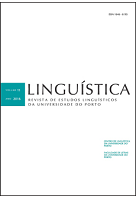Língua Gestual de São Tomé e Príncipe : retrato dos primeiros gestos
Resumo
Neste artigo pretende-se retratar a génese da Língua Gestual de São Tomé e Príncipe. A pedido do Governo de São Tomé e Príncipe (Ministério da Educação, Cultura e Ciência, Célula do Ensino Especial), a Universidade Católica Portuguesa, o Instituto Marquês de Valle Flôr e o Hospital Cuf Infante Santo colaboraram num projeto comum: implementar uma Língua Gestual para os surdos santomenses. A este projeto, financiado pela Fundação Calouste Gulbenkian, deu-se o nome de Projeto Sem Barreiras. O artigo encontra-se estruturado em duas partes: uma primeira parte, em que se descreve, de forma resumida, as principais linhas de ação do projeto, os participantes e a metodologia utilizada; e uma segunda parte em que se analisa a emergência dos primeiros gestos, recorrendo, pontualmente, à comparação com o sucedido em outras línguas emergentes.
Referências
Allan, Keith. 1977. Classifiers. Language, 53, 284-310.
Amaral, Maria Augusta, Coutinho, Amândio, Delgado Martins, Raquel.1994. Para uma Gramática da Língua Gestual Portuguesa, Caminho, Lisboa.
Aronoff, Mark, Meir, Irit, Padden, Carol A. & Sandler, Wendy. 2008. The roots of linguistic organization in a new language. Interaction Studies: Special Issue on Holophrasis vs Compositionality in the Emergence of Protolanguage, 9 (1), 131-150.
Bettencourt, Fernanda. 2015. A ordem das palavras na Língua Gestual Portuguesa: Breve estudo comparativo com o português e outras línguas gestuais, Dissertação de Mestrado apresentada à FLUP.
Carmo, Patrícia, Oliveira, Ricardo & Mineiro, Ana. 2014. Dicionário da Língua Gestual de São Tomé e Príncipe – Dicionário Oficial da República Democrática de São Tomé e Príncipe, Lisboa: UCEditora.
Carvalho, Paulo. 2009. História da Educação de Surdos, I, Lisboa: UCEditora. Carvalho, Paulo. 2011. História da Educação de Surdos, II, Lisboa: UCEditora.
Choupina, Celda, Brito, Ana Maria & Bettencourt, Fernanda. 2015. Morphosyntax of Ditransitive constructions with the verb DAR, 'to give' in Portuguese Sign Language, comunicação apresentada no First Meeting on Morphosyntax of Portuguese Sign Language and other Sign Languages, Porto (neste volume).
Fischer, Susan, D. & van der Hulst, Harry. 2011. Sign Language Structures. In Mark Marschark Patricia Elizabeth Spencer (Eds.). The Oxford Handbook of Deaf Studies, Language, and Education, Volume 1, 2nd Edition, 336-349. Oxford: Oxford University Press.
Klima, Edward, Bellugi, Ursula (1975) The Signs of Language, Harvard University Press, Boston.
Meir, Irit & Sandler, Wendy. 2008. A language in space. The story of Israeli Sign Language. New York, NY: Lawrence Erlbaum.
Meir, Irit, Sandler, Wendy, Padden, Carol & Aronoff, Mark. 2010. Emerging Sign Languages. In Mark Marschark & Patricia Elizabeth Spencer (Eds.). The Oxford Handbook of Deaf Studies, Language and Education, Volume 2, 267-280. Oxford: Oxford University Press.
Mineiro, Ana, Colaço, Dora. 2010. Introdução à Fonética e Fonologia na LGP e na Língua Portuguesa, UCEditora: Lisboa.
Morais, Amílcar, Champalimaud Jardim, João, Silva, Ana & Mineiro, Ana. 2011. Para além das mãos: elementos para o estudo da expressão facial em Língua Gestual Portuguesa, Cadernos de Saúde, 1, vol 4, 37-42.
Nascimento, Sandra Faria, Correia, Margarita. 2011. Um olhar sobre a morfologia dos gestos, UCEditora: Lisboa.
Padden, Carol. 1988. Grammatical theory and signed languages. In F. Newmeyer (Ed.), Linguistics: The Cambridge Survey (Vol. II). Cambridge, MA: Cambridge University Press.
Padden, Carol. 1990. The relation between space and grammar in ASL verb morphology. In C. Lucas (ed.) Proceedings of the second International Conference on Theoretical Issues in Sign Language research. Washington, DC: Gallaudet University Press, 118-132.
Perniss, Pamela, Thompson, Robin. L. & Vigliocco, Gabriella. 2010. Iconicity as a General Property of Language: Evidence from Spoken and Signed Languages. Frontiers in Psychology, 1, 1-15.
Quadros, Ronice M. de & Karnopp, Lodenir B. 2004. Língua de sinais brasileira. Estudos Linguísticos. Porto Alegre: Artmed Editora.
Sacks, Oliver. 1989. Seeing Voices, New York: Vintage Books.
Sandler, Wendy. 1989. Phonological Representation of the Sign: linearity and no-linearity in American sign Language, Foris: Dordecht.
Sandler, Wendy & Lillo-Martin, Diane. 2006. Sign Language and Linguistic Universals, Cambridge University Press: Cambridge.
Schembri, Adam. 1996. The structure and formation of signs in Auslan (Australian Sign Language). Sidney: North Rocks Press.
Senghas, Ann, Coppola, Marie, Newport, Elissa & Supalla, Ted. 1997. Argument structure in Nicaraguan Sign Language: the emergence of grammatical devices. In Elizabeth Hughes, Mary Hughes & Annabel Greenhill (Eds.), The Proceedings of the Boston University conference on language development. Boston, MA: Cascadilla Press, 550-561.
Stokoe, William. 1960. Sign Language Structure. An outline of the visual communication system of American deaf. Studies in Linguistics. Occasional Papers, 8, University of Buffalo: Buffalo, N.Y.
Tang, Gladys. 2003. Verbs of Motion and location in Hong Kong Sign Language: Conflation and Lexicalization In Emmorey, Karen (Ed). Perspectives on Classifier Constructions in Sign Languages, Lawrence Earlbaum Associates, N.J.
Taub, Sarah. F. 2001. Language from the Body - Iconicity and Metaphor in American Sign Language. Cambridge, UK: Cambridge University Press.
Vilhalva, Shirley. 2009. Mapeamento das Línguas de Sinais Emergentes: um estudo sobre as comunidades indígenas de Mato Grosso do Sul. Dissertação de Mestrado em Linguística, Universidade Federal de Santa Catarina.
Downloads
Publicado
Edição
Secção
Licença
Direitos de Autor (c) 2017 Linguística Revista de Estudos Linguísticos da Universidade do Porto

Este trabalho encontra-se publicado com a Creative Commons Atribuição-NãoComercial 4.0.



